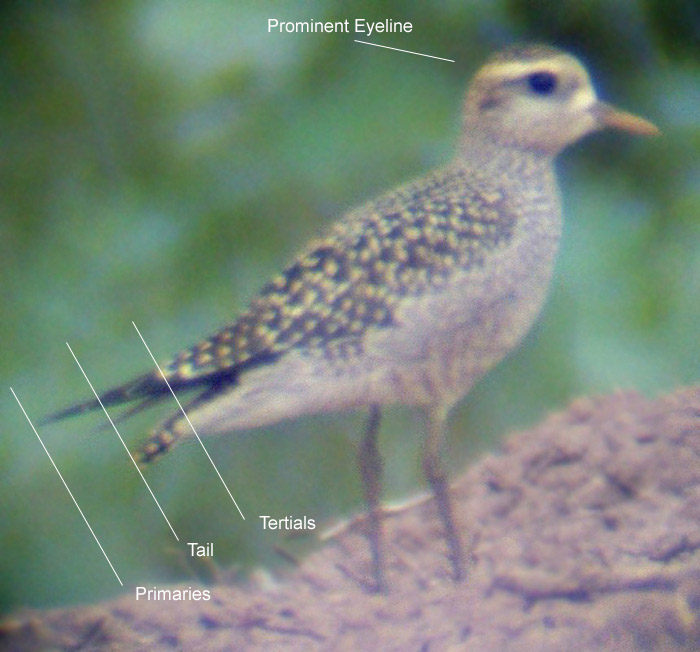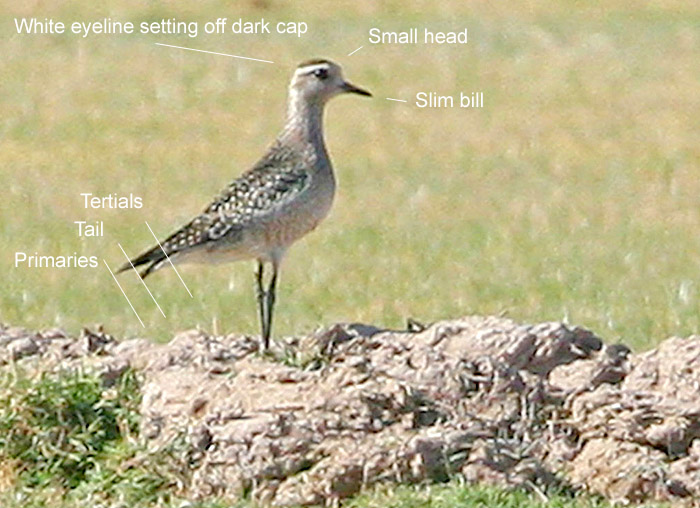 |
 |
|||||||||||||||||||||
|
||||||||||||||||||||||
American Golden-Plover (Pluvialis dominica)
Evaluation of recent Golden-Plover images taken in Arizona and notes on identification.
Andrew Core (andrewcore@gmail.com)
Michael C. Moore (michael.moore@asu.edu)
American Golden-Plover (Pluvialis dominica) is a casual spring and fall transient in Arizona. There are more records in fall and these are generally from late August through mid-November, with most records in September and October. Most fall records are of juveniles. This species presents an ID challenge because it is very similar to Pacific Golden-Plover (Pluvialis fulva). These two forms are so similar that they were only recognized as separate species in 1993. Pacific Golden-Plover has only been recorded once in Arizona (6-12 August 1998). American Golden-Plovers are generally absent from the continental US in winter, but a few Pacifics winter in California.
In many shorebirds, juvenile and nonbreeding adult plumages are very distinctive from each other, but this is not the case in golden-plovers in which juvenile and adult nonbreeding plumage are only subtly different. Juveniles can usually be distinguished from adults by their crisp plumage, neatly spangled upperparts and neatly mottled breast. Juvenile Pacific and American Golden-Plover can usually be distinguished from each other by noting (1) the projection of the primaries and tertials relative to the tail, (2) the pattern and color of the face and breast, and (3) the size of the head and bill (Paulson 2005; O'Brien et al. 2006). Pacific Golden-Plover also has slightly longer legs, which allow for the toes to project slightly past the tail in flight, and a different call.
Two different juvenile American Golden-Plovers were seen in Arizona in fall 2008 and both were photographed. In this paper, we analyze the photographs of these individuals to illustrate the key field marks that separate them from Pacific Golden-Plover.
Fig. 1. This American Golden-Plover was
discovered by Peter Walsh on 25 September 2008 and
photographed by Andrew Core on 26 September 2008 at
Whitewater Draw in Cochise County. Note relative position of the ends
of the tertials, tail and primaries. The short
tertials and long primaries relative to the tail are a
good mark for American Golden-Plover.

26 September 2008, photo by Andrew Core
Analysis of bird in Fig 1.
Primary Projection: American Golden-Plovers have long primaries that always project well past the tail. Pacific Golden-Plovers have shorter primaries that are usually even with the tail or project only slightly past it. In this bird, the primaries project well beyond tail. Although in Pacific the wings may project some, a search of images on the web did not reveal any instances of this much projection in a Pacific. This field mark indicates American Golden-Plover and is one of the best overall field marks to separate these species.
Number of primaries visible: In fresh plumage, most Pacific Golden-Plovers have 2-3 primaries visible past the tertials and most Americans have 4-5. Primaries 9 and 10 are usually more closely spaced in Pacific, but there is overlap in this character. In the field, this bird appeared to have three primaries visible past the tertials, which is often cited as a mark for Pacific, and the pictures are not of sufficient detail to challenge this. However, "It is important to note that very close spacing of primary tips 9 and 10... may give the visual impression of a single feather when viewed in the field, and thus lead to an incorrect count." (see Johnson and Johnson 2004). Therefore, the number of primaries projecting past the tertials in this bird could be three OR four. If three, one is forced to conclude that the p9 and p10 are not closely spaced. Four would fit better with the spacing. This field mark was not conclusive in this case. In general, if 4-5 primaries are visible, that indicates American. If three are visible, it seems inconclusive, especially if P9 and P10 are not closely spaced as they should be, at least in Pacific. It should be noted that the number of primaries visible can be affected by wear of both tertials and primaries and would appear quite different in an actively molting bird.
Tertials: In American, the tertials are usually close to the base of the tail, rarely projecting more than half way down the tail. In Pacific, the tertials are longer and usually reach or nearly reach the end of the tail. In this bird, the primaries are prominently exposed past the tertials and the tertials do not come close to the tip of the tail. This fits quite well with American, and not at all with Pacific.
Color: Juvenile American usually shows few if any yellow tones in this plumage. Juvenile Pacific is overall brighter with bright yellow often on the face and breast. The overall bright color was striking on this bird and while suggestive of Pacific, it is not absolute indicative. Examination of images found by searching on www.flickr.com produced at least two pictures of American that matched the Whitewater bird very well. The lack of yellow on the face and breast of this bird is especially suggestive of American, but the literature suggests there is overlap in these features.
Other marks that fit American are the gray chest and the bright supercillium above and behind the eye. The bright spangles and fresh looking plumage indicate a juvenile. One strange mark is the color of the bill; this bird has a yellow bill with a dark base, and all books and pictures consulted show only a black bill. Is it possible this bird was probing in yellow mud?
In conclusion, the evidence - particularly the primary extension past the tail and length of the tertials - points to this being a brightly colored juvenile American Golden-Plover.
Fig. 2. This bird was found and photographed by Allen and Denise Klaiber in the Santa Cruz Flats area, Pinal
County and was present from from 24-26 October 2008.

24 October 2008, photo by Allen and Denise Klaiber
Analysis of bird in Fig 2:
This juvenile bird shows the typical slim, small-billed, dove-headed look of an American Golden Plover. Pacific Golden-Plover is a bulkier bird and usually has a longer, thicker bill. This bird has a prominent white supercillium setting off the dark cap which is typical of American. Pacific usually has a plainer face, usually with a strong yellow cast. Finally, as in Fig. 1, the primaries project well past the tail whereas the tertials fall well short of the tail, again a characteristic of American Golden-Plover. The number of primary tips is not visible in the photo.
Acknowledgements
We would like to thank Mark Stevenson, John Yerger, Gary Rosenberg,
Gavin Bieber and three anonymous reviewers for helpful comments.
References
Alderfer, J, ed. 2006. Complete Birds of North America. National Geographic Society, Washington.
Johnson, O.W. and Johnson, P.M. 2004. Morphometric features of Pacific and American Golden-Plovers with comments on field identification. Wader Study Group Bull. 103: 42–49.
O'Brien, M., Crossley, R, and Karlson, K. 2006. The Shorebird Guide. Houghton Mifflin, New York.
Paulson, D. 2005. Shorebirds of North America: The Photographic Guide. Princeton University Press, Princeton.
Submitted 1 November 2008
Accepted 26 December 2008
|
©2005
|
HOME | | | REPORT SIGHTINGS | | | PHOTOS | | | BIRDING | | | JOURNAL | | | ABOUT US | | | CHECKLISTS | | | AZ BIRD COMMITTEE | | | EVENTS | | | LINKS |